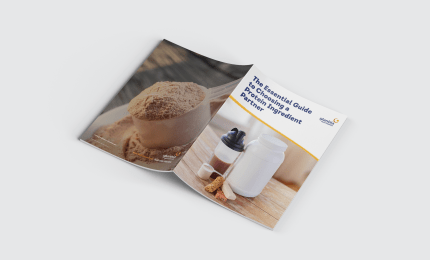Highlights:
Whey protein isolate and whey protein concentrate are different in many ways, including:
- Protein content
- Bioactive levels
- Amount of lactose
- Fat and cholesterol content
- Amino acids

Although whey protein is the gold standard in sports nutrition, deciding between whey protein isolate and whey protein concentrate requires careful consideration because it impacts a variety of factors, ranging from lactose to leucine content.
Whey protein isolate and whey protein concentrate are different in many ways, including:
Consumers turn to protein products for reasons that include wellbeing, weight management, strength, and exercise recovery. But to give consumers the best possible fuel to support these goals, it’s important for manufacturers to understand that all proteins are not created equal.
There are a lot of different proteins being used in products today—from dairy-based options like whey and milk proteins to plant-based proteins like pea, which are trending big in sports nutrition. But even if products are formulated to have the same amount of protein, the quality of the protein makes a big difference in what it actually provides the body.
Whey protein has long been the preferred protein for sports nutrition applications due to its perfect PDCAAS of 1.00. This means it contains all the essential amino acids that the body requires in the right proportion to meet the body’s needs. There is no shortage of any amino acid, unlike many plant proteins, for example.

Among whey protein ingredients, there are also important distinctions. Here’s a look at some key differences between the two most popular whey protein ingredients: whey protein isolate (WPI) and whey protein concentrate (WPC).
Perhaps the best-known difference between WPI and WPC is protein content. WPC can contain up to 80% protein, while WPI contains 90%. This means less WPI is required to achieve a finished product’s target protein content.

Download our eGuide today!
Whey protein naturally includes a number of bioactive compounds such as glycomacropeptide (GMP), alpha-lactalbumin, and beta-lactoglobulin, which have been researched for various beneficial effects on the body. When WPI is processed via cross-flow microfiltration like Provon CFM™ Whey Protein Isolate, these bioactives are preserved, resulting in higher bioactive levels than WPC.
During the additional processing it takes to go from a WPC 80% to a WPI 90%, a lot of unnecessary components are removed, including lactose. This is why WPI is extremely low in lactose (less than 1%, compared to about 5% for WPC), making it an excellent choice for target consumers who are sensitive to lactose.

Likewise, a significant amount of fat and cholesterol are removed during the processing of WPI. The fat content of WPI is less than 1%, compared to about 8% for WPC 80%, and WPI is virtually cholesterol-free. These features can be important for products targeting consumers who are watching their fat and cholesterol intake.
WPI is also high in branched-chain amino acids (BCAAs)—including leucine, which research shows plays an essential role in muscle protein synthesis and growth. Provon CFMTM Whey Protein Isolate has 23 grams of BCAAs per 100 grams of powder—6 grams more than WPC 80%—and 11 grams of leucine, compared to 8 grams for WPC.
While the high purity of WPI offers key nutrition benefits for sports nutrition products, WPC has important uses in dairy and bakery products, for example, and is known for its pleasant, creamy taste. Learn more about the options in whey protein solutions for your products, including our high-quality Provon® Whey Protein Isolates and Avonlac® Whey Protein Concentrates.